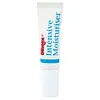What's inside
What's inside
 Key Ingredients
Key Ingredients

 Benefits
Benefits

 Concerns
Concerns

 Ingredients Side-by-side
Ingredients Side-by-side

Water
Skin ConditioningHydrogenated Polyisobutene
EmollientCera Alba
EmollientPetrolatum
EmollientEthylhexyl Methoxycinnamate
UV AbsorberSorbitan Isostearate
EmulsifyingAlcohol Denat.
AntimicrobialHydrogenated Soy Polyglycerides
Skin ConditioningGlycerin
HumectantPolysorbate 60
EmulsifyingPolyglyceryl-3 Diisostearate
EmulsifyingCetyl Alcohol
EmollientStearyl Behenate
EmollientMentha Piperita Oil
MaskingAllantoin
Skin ConditioningAroma
Camphor
MaskingDimethicone
EmollientOlea Europaea Fruit Oil
MaskingAmmonium Hydroxide
BufferingArachidyl Alcohol
EmollientArachidyl Glucoside
EmulsifyingBehenyl Alcohol
EmollientButyrospermum Parkii Butter
Skin ConditioningC15-23 Alkane
SolventCalcium Disodium EDTA
Citric Acid
BufferingHydrated Silica
AbrasiveLanolin
EmollientLauric Acid
CleansingLimonene
PerfumingLinalool
PerfumingMyristic Acid
CleansingOleic Acid
EmollientPalmitic Acid
EmollientPhosphoric Acid
BufferingSodium Hydroxide
BufferingSodium Saccharin
MaskingSorbitan Olivate
EmulsifyingThymol
AntimicrobialWater, Hydrogenated Polyisobutene, Cera Alba, Petrolatum, Ethylhexyl Methoxycinnamate, Sorbitan Isostearate, Alcohol Denat., Hydrogenated Soy Polyglycerides, Glycerin, Polysorbate 60, Polyglyceryl-3 Diisostearate, Cetyl Alcohol, Stearyl Behenate, Mentha Piperita Oil, Allantoin, Aroma, Camphor, Dimethicone, Olea Europaea Fruit Oil, Ammonium Hydroxide, Arachidyl Alcohol, Arachidyl Glucoside, Behenyl Alcohol, Butyrospermum Parkii Butter, C15-23 Alkane, Calcium Disodium EDTA, Citric Acid, Hydrated Silica, Lanolin, Lauric Acid, Limonene, Linalool, Myristic Acid, Oleic Acid, Palmitic Acid, Phosphoric Acid, Sodium Hydroxide, Sodium Saccharin, Sorbitan Olivate, Thymol
Paraffinum Liquidum
EmollientCera Microcristallina
Emulsion StabilisingParaffin
PerfumingHydrogenated Polydecene
EmollientDimethicone
EmollientTriacontanyl Pvp
HumectantDipentaerythrityl Tetrahydroxystearate/Tetraisostearate
Skin ConditioningGlycerin
HumectantSqualane
EmollientBrassica Campestris Sterols
EmollientTocopheryl Acetate
AntioxidantSynthetic Wax
AbrasiveEthylene/Propylene Copolymer
AbrasivePolyethylene
AbrasivePolyquaternium-61
Skin ConditioningBHT
AntioxidantParaffinum Liquidum, Cera Microcristallina, Paraffin, Hydrogenated Polydecene, Dimethicone, Triacontanyl Pvp, Dipentaerythrityl Tetrahydroxystearate/Tetraisostearate, Glycerin, Squalane, Brassica Campestris Sterols, Tocopheryl Acetate, Synthetic Wax, Ethylene/Propylene Copolymer, Polyethylene, Polyquaternium-61, BHT
 Reviews
Reviews

Alternatives
Ingredients Explained
These ingredients are found in both products.
Ingredients higher up in an ingredient list are typically present in a larger amount.
Dimethicone is a type of synthetic silicone created from natural materials such as quartz.
What it does:
Dimethicone comes in different viscosities:
Depending on the viscosity, dimethicone has different properties.
Ingredients lists don't always show which type is used, so we recommend reaching out to the brand if you have questions about the viscosity.
This ingredient is unlikely to cause irritation because it does not get absorbed into skin. However, people with silicone allergies should be careful about using this ingredient.
Note: Dimethicone may contribute to pilling. This is because it is not oil or water soluble, so pilling may occur when layered with products. When mixed with heavy oils in a formula, the outcome is also quite greasy.
Learn more about DimethiconeGlycerin is already naturally found in your skin. It helps moisturize and protect your skin.
A study from 2016 found glycerin to be more effective as a humectant than AHAs and hyaluronic acid.
As a humectant, it helps the skin stay hydrated by pulling moisture to your skin. The low molecular weight of glycerin allows it to pull moisture into the deeper layers of your skin.
Hydrated skin improves your skin barrier; Your skin barrier helps protect against irritants and bacteria.
Glycerin has also been found to have antimicrobial and antiviral properties. Due to these properties, glycerin is often used in wound and burn treatments.
In cosmetics, glycerin is usually derived from plants such as soybean or palm. However, it can also be sourced from animals, such as tallow or animal fat.
This ingredient is organic, colorless, odorless, and non-toxic.
Glycerin is the name for this ingredient in American English. British English uses Glycerol/Glycerine.
Learn more about Glycerin